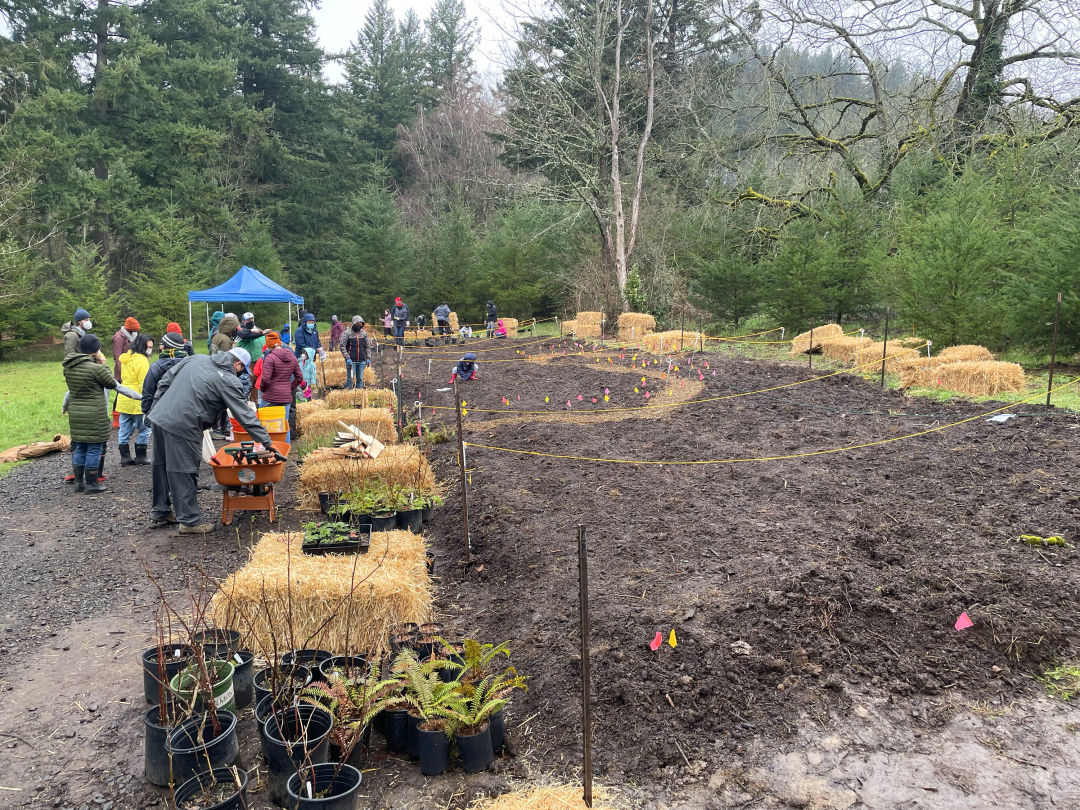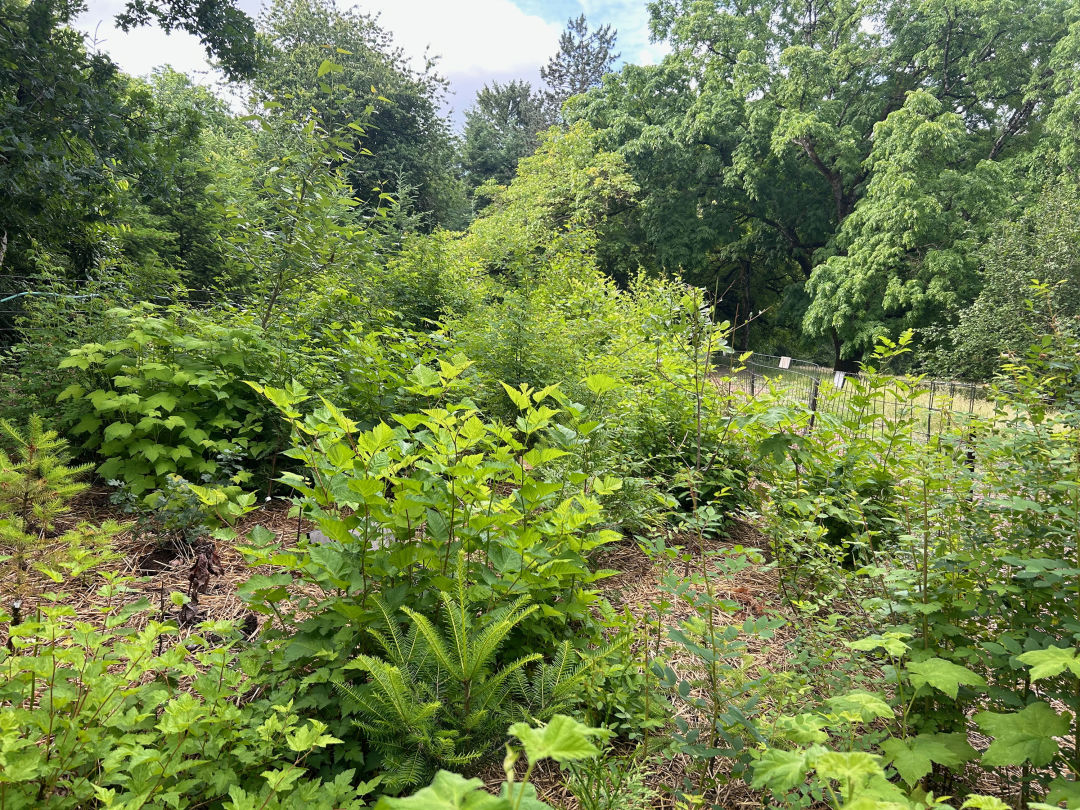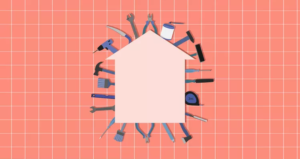Goodbye, plant beds and street view. Hello, woodlands.

Why wait for other people to solve the climate crisis when you can create wee woodlands right in your own yard? Enter the tiny forest movement, which took root in Japan a couple of decades ago and is now jumping the pond to Oregon.
Just ask Andrew Millison, who grows 30 trees and native berry bushes in his tiny forest. His one-third-acre corner lot in suburban Corvallis looks like a rainforest from above; from the street, trees and foliage completely block the house from view. Millison founded the permaculture design program at Oregon State University, and he aims to show neighbors the possibilities of abundant foliage on small lots, and to provide passersby with a browsable, edible landscape. “Permaculture is a road map to making your home and garden paradise,” he says. Or at least very leafy.
Less Is Mori
Portland’s reverence for forests is shared by the Japanese, so it’s little surprise that the concept of creating pocket-size forests emerged from Japan. The concept was born in the 1970s by plant ecologist Akira Miyawaki, who noticed that the small, undisturbed forests surrounding Shintō shrines, called chinju-no-mori, looked healthier than the tree plantations commonly installed after logging. Miyawaki developed an approach to reforestation that involves restoring soils and then planting very densely. How densely?? I hear you asking. A robust 20,000–30,000 trees per hectare is the Miyawaki method; this comes out to around 8,000–12,000 trees per acre, which is 8–12 times denser than the norm for reforesting timberlands … or roughly one tree for every 3–5 square feet.
Planting trees in a clump is not unlike sowing a vegetable garden bed with a few seeds per hole. Once started, tiny forests fill vertical space fast. Think of the scene in My Neighbor Totoro, when Satsuki and Mei look out the window one moonlit night to see Totoro and friends marching around a small garden where the girls have planted acorns, coaxing the soil to spring forth. Within moments, seedlings sprout and magically burst into a thick grove of giant trees. It doesn’t happen quite that fast in real life, but that’s not much of an exaggeration. A tiny forest usually goes from bare earth to lush copse in just a couple of years, substantially faster than on tree plantations. Some keep growing beyond one property. In Southeast Portland’s Sunnyside neighborhood, Evrim Icoz shares a property line with Esther Lev, a retired executive director of the Wetlands Conservancy, and their unfenced, naturescaped yards blend into one contiguous habitat. His plants are “really happy, so they tend to take over a little bit sometimes,” Icoz says. “The bleeding hearts and the Oregon grape escape to my neighbor’s yard.”
Yet even wayward tiny forests have many benefits. At a small scale, thick patches of trees sequester carbon and improve air quality, slow stormwater, and cool the air. They also look really neat. But they do function differently than typical forests. Survival rates are initially fairly high—85 to 90 percent for the first three years—though that number drops precipitously once you cut irrigation (you’re supposed to water for three years), and dips again as the trees grow and begin to self-thin, which happens when trees compete for sunlight, soil, and moisture. And trees alone do not make a diverse forest: in wild forests, a diversity of tree, shrub, and herbaceous species occupy distinct vertical niches, called strata. Free-growing forests rotate through sequences of ecological communities over time, while tiny forests mostly maintain the species that you plant. Adding shrubs and flowering plants from the beginning will bring that I-am-a-jungle-dweller feel.

Tiny forest planting day at Catlin Gabel in 2022
Image: courtesy catlin gabel
Stumptown, Eh?
Why go for tiny forests in a tree-loving town like Portland? It’s easy to assume all is well with Portland trees. Our darling (yet unimaginatively named) Forest Park is one of the largest urban greenspaces in the world. And walk around beyond downtown and you’ll see very average-size lots randomly dotted with massive trees, like the three 150-plus-year-old giant sequoias in Save the Giants Park, or the odd forested natural area that isn’t a designated park (we’re looking at you, River View Natural Area). But tree canopy in Portland dropped between 2015 and 2020, losing 823 acres. Though that’s a less than 1 percent loss in total tree cover, it’s the wrong direction. We also have some of the smallest backyards in America, so tiny forests might be all we can muster. Small collective actions have big benefits.
Patches of mature trees still exist, left standing by housing developers of yore, especially in the West Hills, to facilitate scenic views and better bird-watching. Drive through pretty much any suburban subdivision and you’ll doubtless see what appears to be a tiny forest—and is actually a compensatory mitigation site, replanted by requirement, after developments impacted wetlands or waterways.
But classic, Miyawaki-method tiny forests are rare here, especially at companies or organizations—in fact, Catlin Gabel School has the only one in the city, and it was planted two years ago. Portland has largely had to rely on homeowner altruism (and the hypothetical lure of increased property values) to prioritize trees. It’s 100 percent legal to grow a tiny forest at your house. No permit is required to plant trees on private property (unless you’re planting designated nuisance species like holly or English hawthorn, which you wouldn’t want to do anyway). The city provides a helpful official list of suggested trees and shrubs. Tiny forests don’t need to include food plants, but Millison appreciates edible tiny forests, which can also support wildlife corridors and pollinator habitats. He shies away from native-plants-only ideology, especially in urban and suburban settings. “We don’t just eat native plants,” he says. “If you’re buying food from the grocery store, then you’re displacing native plants from somewhere else.”

The Catlin Gabel tiny forest today
Image: courtesy catlin gabel
Potential Snags
It’s worth mentioning possible drawbacks. First, anyone who loves gardening knows that plants are expensive. However, you can get free (or nearly free) permits to collect native plants under two feet tall for personal use in many of Oregon’s state and national forests—you just have to drive out and dig them up yourself (and follow the rules about which species you can take). You’ll probably need to amend your soil, and newly planted areas will require irrigation for years, so factor that into your cost estimate. (On the plus side, it’ll be too shady for you to grow many vegetables, so you’ll save on tomato starts!)
Densely planted areas can also create an “if you build it, they will come” situation. In my decade working as a wetland mitigation specialist, almost all the urban restoration sites and natural areas I monitored faced anthropogenic impacts, from illegal dumping to camping. And hungry deer and rodents can annihilate a freshly planted site with a merciless quickness.
A final consideration: your neighbors might think it’s ugly. My own have griped about my trees along their property line; I simply remind them that birds need a place to hide from their cats. And a bit of neighbor tension is a small price to pay for living in leafy paradise. “The world could be a garden of Eden,” says Millison, “if we choose to make it one.”
How to build a tiny forest of your own
Read up on Miyawaki. Start with Mini-Forest Revolution by Hannah Lewis.
Pick the right plants. If you’re envisioning a haven where birds hide from outdoor cats (or you fancy heavy metal naturescaping), think about a thicket of spiny plants like black hawthorn, Nootka rose, Oregon grape, devil’s club, and stinging nettle. Hot and dry spots aren’t ideal for moisture-loving Pacific willow, red alder, or western red cedar; in shady sites, keystone species like Douglas fir and Oregon white oak will suffer.
Add zones. Put edible or fragrant plants closer to human paths, and native plants further away, where they can sit densely and provide greater benefit.
Team up. The Facebook group Friends of Backyard Habitats for greater Portland (11,000 members) is where many neighbors partner up to maximize efforts.
Get certified. The Backyard Habitat Certification Program, a partnership between the Bird Alliance of Oregon and Columbia Land Trust, offers on-site guidance and coupons for native plants, and you’ll even get a little yard plaque to lord over your neighbors.
Don’t forget a rain garden. Tiny forests slow down storm runoff before it enters sewers and streams. Check with the Portland Bureau of Environmental Services for information on creating a rain garden. The city even provided free native shrubs and groundcovers when its team installed my rain garden back in 2018, and let me choose the species. Planting trees also earns you a discount on your sewer bill.
For this and related articles, please visit Portland Monthly









































/cdn.vox-cdn.com/uploads/chorus_image/image/73566034/4_NEW.7.png)

